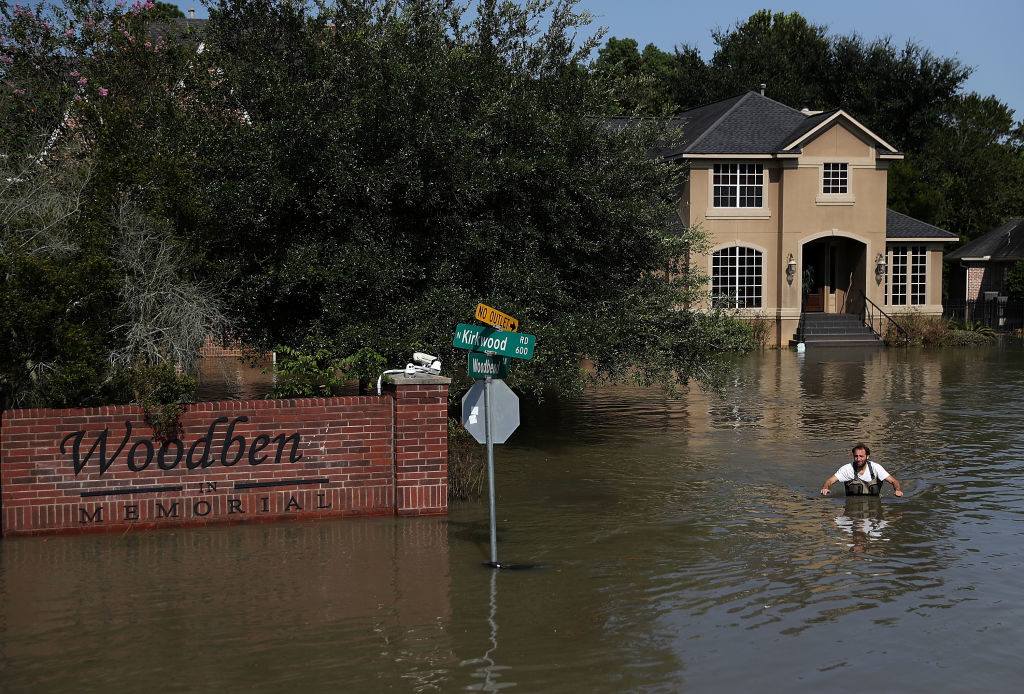As Harvey’s record-setting rainfall inundated wide swaths of coastal Texas, expert researchers in natural disaster planning, recovery and sustainability at the Texas A&M College of Architecture, in penned columns and numerous interviews with print, TV and radio journalists, described how land development practices exacerbated the flooding and prescribed actions to mitigate flood damage in the future.
Unbridled growth contributed to flooding
In a BBC-commissioned piece, Phil Berke, professor of urban planning and director of the Texas A&M Institute for Sustainable Communities, said the loss of wetlands and other results of rapid, but poorly planned growth explains Houston’s increasing flood vulnerability.
“Growth itself is not a problem, as it can create economic, social and environmental benefits for cities,” he said. “But poorly planned growth which fails to carefully manage land use — for housing, businesses and the infrastructure like roads, parks and sewers that cities need — can create problems and even lead to disasters.”
For the region to thrive in the coming century, Berke continued, better coordinated planning decisions between federal, state and local government entities is sorely needed.
Berke also provided examples of policies adopted by other cities that could help Houston reduce its flood vulnerability.
“Faced with coastal storms and rising sea levels on the Atlantic coast, Norfolk, Va, has adopted long-term strategies for guiding future land use and development,” he said. “For example, areas at low risk of flooding where there has so far been limited development will be transformed into high density and mixed-income neighborhoods.”
In high-risk areas, he said, city plans call for buyouts to distance housing in established areas from shorelines, and maintaining, but not expanding, sewer and water lines.
Read article: “Why is Houston so vulnerable to devastating floods?”
An emphasis on disaster protection
The current practice of landscape-altering development put tens of thousands of people in harm’s way, Sam Brody, professor of urban planning, told HBO’s Vice News Tonight in a segment that aired Sept. 6, 2017.
“I don’t think you can put the blame on one agency or individual. It’s a collection of factors working together,” said Brody, who has a joint appointment to the Department of Marine Sciences at Texas A&M University at Galveston, where he holds the George P. Mitchell ’40 Endowed Chair in Sustainable Coasts and directs the Center for Texas Beaches and Shores.
The time is now, he said, for the region to make a fundamental change in the way it conceives and acts upon flood risk.
“We need to go beyond recovery and fundamentally start changing the way we’re dealing with these problems and move away from recovery, more towards protection.”
Brody’s concerns were detailed in the March 3, 2016 Texas Tribune-Pro Publica report “Hell and High Water,” which went on to earn its authors an Edward R. Murrow Award for investigative reporting.
Planning before disaster strikes
In a Sept. 3, 2017 San Antonio Express-News editorial, Shannon Van Zandt championed the importance of communities, builders, engineers, architects and caseworkers collaborating to establish a housing recovery program before a natural disaster strikes.
“Pre-recovery planning enhances resilience by mitigating population displacement, maintaining social networks, speeding recovery and rebuilding, and providing cost-effective solutions. Importantly, it also engages community stakeholders in developing a vision for the future of their community,” she said.
She and an array of housing advocates are lobbying for new laws to enable such efforts across the state.
In 2015 and 2017 legislative sessions, Van Zandt testified in legislative committee hearings in support of pre-recovery planning bills, which have garnered bipartisan support but have yet to reach the governor’s desk.
“So, again, we find ourselves no better prepared to take on a natural disaster like Hurricane Harvey than we were when Hurricane Ike struck Galveston nine years ago,” she said. “As a result, people are suffering, property is being damaged, and local governments, local businesses and the state of Texas are losing money and will require outside help to recover.”
Read Van Zandt’s editorial: “A better way to speed recovery from Harvey.”
Low-income residents fare worse in disasters
Another step Houston and Harris County can take to increase their flood resilience is to stop allowing housing and commercial developments in low, flood-vulnerable areas, said Berke in a Fast Company article by Adele Peters.
These are areas, Van Zandt said in the same article, where low income housing is often located.
“One of the findings that is most robust in the disaster literature is that low-income families and families of color will receive a greater degree of damage to begin with,” she said. Recovery, research shows, can take two to four times longer for low-income families or families of color than for other households.
The Houston region, said Berke, should be more proactive in identifying where development should happen, building up green infrastructure, and considering more creative approaches, like innovative storm water runoff measures undertaken in Rotterdam, The Netherlands, 90 percent of which lies below sea level.
Read the Adele Peters’ article: “How Houston Can Become More Resilient To Future Floods.”
Harvey could spur lasting land use changes
Since Harvey’s rains affected so many areas of Houston, the region might finally approach land development more intelligently, said Van Zandt in a Washington Post opinion piece by Jonathan Katz.
“I hate to say it, but I think that because not just low-income people have been affected, there may be more of a reaction from middle- and upper-income folks,” she said.
In the meantime, she said, low-income households will struggle to recover.
“They lack a lot of resources,” she said, including insurance, especially flood insurance, which the poor are less likely to have, as well as information and social resources that help them access assistance.
The key, she added, is for people to understand that a disaster like Harvey is in essence a manmade event — the collision of a storm and a human-built environment.
Read the Jonathan Katz article: “Who Suffers When Disasters strike? The Poorest and Most Vulnerable.”
###
Continue reading this story by Richard Nira on ArchOne.





